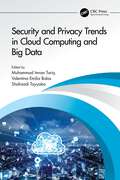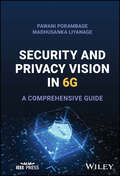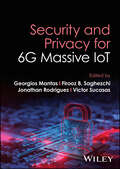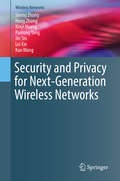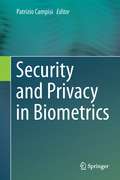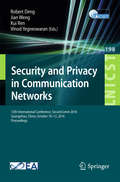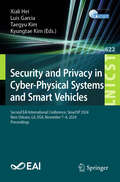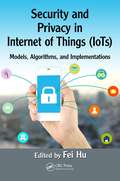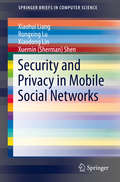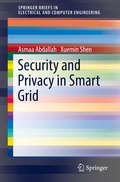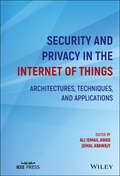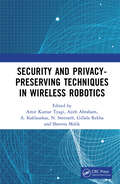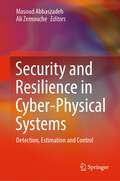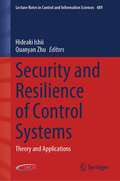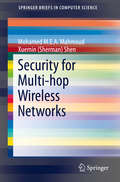- Table View
- List View
Security and Privacy Trends in Cloud Computing and Big Data
by Muhammad Imran TariqIt is essential for an organization to know before involving themselves in cloud computing and big data, what are the key security requirements for applications and data processing. Big data and cloud computing are integrated together in practice. Cloud computing offers massive storage, high computation power, and distributed capability to support processing of big data. In such an integrated environment the security and privacy concerns involved in both technologies become combined. This book discusses these security and privacy issues in detail and provides necessary insights into cloud computing and big data integration. It will be useful in enhancing the body of knowledge concerning innovative technologies offered by the research community in the area of cloud computing and big data. Readers can get a better understanding of the basics of cloud computing, big data, and security mitigation techniques to deal with current challenges as well as future research opportunities.
Security and Privacy Trends in the Industrial Internet of Things (Advanced Sciences and Technologies for Security Applications)
by Cristina AlcarazThis book, written by leaders in the protection field of critical infrastructures, provides an extended overview of the technological and operative advantages together with the security problems and challenges of the new paradigm of the Internet of Things in today’s industry, also known as the Industry Internet of Things (IIoT). The incorporation of the new embedded technologies and the interconnected networking advances in the automation and monitoring processes, certainly multiplies the functional complexities of the underlying control system, whilst increasing security and privacy risks. The critical nature of the application context and its relevance for the well-being of citizens and their economy, attracts the attention of multiple, advanced attackers, with stealthy abilities to evade security policies, ex-filter information or exploit vulnerabilities. Some real-life events and registers in CERTs have already clearly demonstrated how the control industry can become vulnerable to multiple types of advanced threats whose focus consists in hitting the safety and security of the control processes. This book, therefore, comprises a detailed spectrum of research papers with highly analytical content and actuation procedures to cover the relevant security and privacy issues such as data protection, awareness, response and resilience, all of them working at optimal times. Readers will be able to comprehend the construction problems of the fourth industrial revolution and are introduced to effective, lightweight protection solutions which can be integrated as part of the new IIoT-based monitoring ecosystem.
Security and Privacy Vision in 6G: A Comprehensive Guide
by Madhusanka Liyanage Pawani PorambageSECURITY AND PRIVACY VISION IN 6G Prepare for the future of mobile communication with this comprehensive study 6G is the next frontier in mobile communication, with development of 6G standards slated to begin as early as 2026. As telecommunications networks become faster and more intelligent, security and privacy concerns are critical. In an increasingly connected world, there is an urgent need for user data to be safeguarded and system security enhanced against a new generation of threats. Security and Privacy Vision in 6G provides a comprehensive survey of these threats and the emerging techniques for safeguarding against them. It includes mechanisms for prediction, detection, mitigation, and prevention, such that threats to privacy and security can be forestalled at any stage. Fully engaged with proposed 6G architectures, it is an essential resource for mobile communications professionals looking for a head start on the technology of the future. Security and Privacy Vision in 6G readers will also find: Detailed coverage of topics including edge intelligence and cloudification, industrial automation, collaborative robots, and more Treatment balancing the practical and the theoretical An editorial team with decades of international network technology experience in both industry and academia Security and Privacy Vision in 6G is a vital reference for network security professionals and for postgraduate and advanced undergraduate students in mobile communications and network security-related fields.
Security and Privacy for 6G Massive IoT
by Jonathan Rodriguez Victor Sucasas Georgios Mantas Firooz B. SaghezchiAnticipate the security and privacy threats of the future with this groundbreaking text The development of the next generation of mobile networks (6G), which is expected to be widely deployed by 2030, promises to revolutionize the Internet of Things (IoT), interconnecting a massive number of IoT devices (massive IoT) on a scale never before envisioned. These devices will enable the operation of a wide spectrum of massive IoT applications such as immersive smart cities, autonomous supply chain, flexible manufacturing and more. However, the vast number of interconnected IoT devices in the emerging massive IoT applications will make them vulnerable to an unprecedented variety of security and privacy threats, which must be anticipated in order to harness the transformative potential of these technologies. Security and Privacy for 6G Massive IoT addresses this new and expanding threat landscape and the challenges it poses for network security companies and professionals. It offers a unique and comprehensive understanding of these threats, their likely manifestations, and the solutions available to counter them. The result creates a foundation for future efforts to research and develop further solutions based on essential 6G technologies. Readers will also find: Analysis based on the four-tier network architecture of 6G, enhanced by Edge Computing and Edge Intelligence Detailed coverage of 6G enabling technologies including blockchain, distributed machine learning, and many more Scenarios, use cases, and security and privacy requirements for 6G Massive IoT applications Security and Privacy for 6G Massive IoT is ideal for research engineers working in the area of IoT security and designers working on new 6G security products, among many others.
Security and Privacy for Implantable Medical Devices
by Sandro Carrara Wayne BurlesonThis book presents a systematic approach to analyzing the challenging engineering problems posed by the need for security and privacy in implantable medical devices (IMD). It describes in detail new issues termed as lightweight security, due to the associated constraints on metrics such as available power, energy, computing ability, area, execution time, and memory requirements. Coverage includes vulnerabilities and defense across multiple levels, with basic abstractions of cryptographic services and primitives such as public key cryptography, block ciphers and digital signatures. Experts from Computer Security and Cryptography present new research which shows vulnerabilities in existing IMDs and proposes solutions. Experts from Privacy Technology and Policy will discuss the societal, legal and ethical challenges surrounding IMD security as well as technological solutions that build on the latest in Computer Science privacy research, as well as lightweight solutions appropriate for implementation in IMDs.
Security and Privacy for Mobile Healthcare Networks
by Xuemin Sherman Shen Kuan ZhangThis book examines state-of-art research on designing healthcare applications with the consideration of security and privacy. It explains the Mobile Healthcare Network (MHN) architecture and its diverse applications, and reviews the existing works on security and privacy for MHNs. Critical future challenges and research problems are also identified. Using a Quality-of-Protection perspective, the authors provide valuable insights on security and privacy preservation for MHNs. Some promising solutions are proposed to accommodate the issues of secure health data transmission, misbehavior detection, health data processing with privacy preservation and access control in MHNs. Specifically, the secure health data aggregation explores social spots to help forward health data and enable users to select the optimal relay according to their social ties and health data priority. The secure aggregation achieves the desirable delivery ratio with reasonable communication costs and lower delay for the data in different priorities. A proposed misbehavior detection scheme distinguishes Sybil attackers from normal users by comparing their mobile contacts and pseudonym changing behaviors. The detection accuracy is high enough to resist various Sybil attacks including forgery. In addition, the health data processing scheme can analyze the encrypted health data and preserve user's privacy at the same time. Attribute based access control can achieve fine-grained acces s control with user-defined access policy in MHNs. Security and Privacy for Mobile Healthcare Networks is designed for researchers and advanced-level students interested in healthcare security and secure data transmission.
Security and Privacy for Next-Generation Wireless Networks (Wireless Networks)
by Lei Xie Xinyi Huang Sheng Zhong Kun Wang Hong Zhong Panlong Yang Jin ShiThis timely book provides broad coverage of security and privacy issues in the macro and micro perspective. In macroperspective, the system and algorithm fundamentals of next-generation wireless networks are discussed. In micro-perspective, this book focuses on the key secure and privacy techniques in different emerging networks from the interconnection view of human and cyber-physical world. This book includes 7 chapters from prominent international researchers working in this subject area. This book serves as a useful reference for researchers, graduate students, and practitioners seeking solutions to wireless security and privacy related issues Recent advances in wireless communication technologies have enabled the large-scale deployment of next-generation wireless networks, and many other wireless applications are emerging. The next generation of mobile networks continues to transform the way people communicate and access information. As a matter of fact, next-generation emerging networks are exploiting their numerous applications in both military and civil fields. For most applications, it is important to guarantee high security of the deployed network in order to defend against attacks from adversaries, as well as the privacy intrusion. The key target in the development of next-generation wireless networks is to promote the integration of the human, cyber, and physical worlds. Previous work in Cyber Physical Systems (CPS) considered the connection between the cyber world and the physical world. In the recent studies, human involvement brings new channels and initiatives in this interconnection. In this integration process, security and privacy are critical issues to many wireless network applications, and it is a paramount concern for the growth of next-generation wireless networks. This is due to the open nature of wireless communication and the involvement of humans. New opportunities for tackling these security and privacy issues in next-generation wireless networks will be achieved by leveraging the properties of interaction among human, computers and things.
Security and Privacy in Biometrics
by Patrizio CampisiThis important text/reference presents the latest secure and privacy-compliant techniques in automatic human recognition. Featuring viewpoints from an international selection of experts in the field, the comprehensive coverage spans both theory and practical implementations, taking into consideration all ethical and legal issues. Topics and features: presents a unique focus on novel approaches and new architectures for unimodal and multimodal template protection; examines signal processing techniques in the encrypted domain, security and privacy leakage assessment, and aspects of standardization; describes real-world applications, from face and fingerprint-based user recognition, to biometrics-based electronic documents, and biometric systems employing smart cards; reviews the ethical implications of the ubiquity of biometrics in everyday life, and its impact on human dignity; provides guidance on best practices for the processing of biometric data within a legal framework.
Security and Privacy in Communication Networks
by Robert Deng Jian Weng Kui Ren Vinod YegneswaranThisvolume constitutes the thoroughly refereed post-conference proceedings of the11th International Conference on Security and Privacy in CommunicationNetworks, SecureComm 2015, held in Dallas, TX, USA, in October 2015. The 29 regular and 10 poster papers presented were carefullyreviewed and selected from 107 submissions. It also presents 9 papers acceptedof the workshop on Applications and Techniques in Cyber Security, ATCS 2015. The papers are grouped in the following topics: mobile, system,and software security; cloud security; privacy and side channels; Web andnetwork security; crypto, protocol, and model.
Security and Privacy in Cyber-Physical Systems and Smart Vehicles: First EAI International Conference, SmartSP 2023, Chicago, USA, October 12-13, 2023, Proceedings (Lecture Notes of the Institute for Computer Sciences, Social Informatics and Telecommunications Engineering #552)
by Bo Chen Yu Chen Chung-Wei Lin Qi ZhuThis book constitutes the refereed proceedings of the First EAI International Conference, SmartSP 2023, held in Chicago, USA, during October 12-13, 2023. The 11 revised full papers were carefully reviewed and selected from 24 submissions. The papers focus on all details all technological aspects that are relevant to Security and privacy in cyber-physical systems.
Security and Privacy in Cyber-Physical Systems and Smart Vehicles: Second EAI International Conference, SmartSP 2024, New Orleans, LA, USA, November 7–8, 2024, Proceedings (Lecture Notes of the Institute for Computer Sciences, Social Informatics and Telecommunications Engineering #622)
by Xiali Hei Luis Garcia Taegyu Kim Kyungtae KimThis book LNICST 622 constitutes the refereed proceedings of the Second EAI International Conference on Security and Privacy in Cyber-Physical Systems and Smart Vehicles, SmartSP 2024, held in New Orleans, LA, USA, during November 7–8, 2024. The 18 full papers were carefully reviewed an selected from 47 submissions. The proceedings focus on Emerging Applications, Hardware and Firmware Security, Adversarial Attacks in Autonomous Systems, Ethics, Privacy, Human-Centric Considerations and Security Techniques for Cyber-Physical Systems.
Security and Privacy in Cyberspace (Blockchain Technologies)
by Manoj Kumar Omprakash Kaiwartya Ashutosh Mishra Keshav Kaushik Sachin Kumar GuptaThis book highlights the literature and the practical aspects to understand cybersecurity and privacy in various networks and communication devices. It provides details of emerging technologies on various networks by protecting the privacy and security of cyberspace. This book presents state-of-the-art advances in the field of cryptography and network security, cybersecurity and privacy, providing a good reference for professionals and researchers.
Security and Privacy in Internet of Things (IoTs): Models, Algorithms, and Implementations
by Fei HuThe Internet of Things (IoT) has attracted strong interest from both academia and industry. Unfortunately, it has also attracted the attention of hackers. Security and Privacy in Internet of Things (IoTs): Models, Algorithms, and Implementations brings together some of the top IoT security experts from around the world who contribute their knowledg
Security and Privacy in Mobile Social Networks
by Xiaodong Lin Rongxing Lu Xuemin Shen Xiaohui LiangThis book focuses on three emerging research topics in mobile social networks (MSNs): privacy-preserving profile matching (PPM) protocols, privacy-preserving cooperative data forwarding (PDF) protocols, and trustworthy service evaluation (TSE) systems. The PPM helps two users compare their personal profiles without disclosing the profiles. The PDF helps users forward data to their friends via multiple cooperative relay peers while preserving their identity and location privacy. The TSE enables users to locally share service reviews on the vendors such that users receive more valuable information about the services not only from vendors but also from their trusted social friends. The authors address both theoretic and practical aspects of these topics by introducing the system model, reviewing the related works, and presenting the solutions. Security and Privacy for Mobile Social Networks further provides the security analysis and the performance evaluation based on real-trace simulations. It also summarizes the future research directions for this rapidly growing area of research. The book will be valuable for researchers and practitioners who work with mobile social networks, communication platforms, wireless communication techniques, and internet applications. "Suitable for any type of reader as an introduction to the topic. . . The chapters are well motivated and presented. . . It is recommended for researchers. " -ACM Computing Reviews, 21 July 2014
Security and Privacy in Smart Grid (SpringerBriefs in Electrical and Computer Engineering)
by Xuemin Shen Asmaa AbdallahThis SpringerBrief addresses the main security concerns for smart grid, e.g., the privacy of electricity consumers, the exchanged messages integrity and confidentiality, the authenticity of participated parties, and the false data injection attacks. Moreover, the authors demonstrate in detail the various proposed techniques to secure the smart grid’s different communication networks and preserve the privacy of the involved. Over many years, power grid has generated electricity from central generators and distributed it in one direction from the generation stations to end-users; also, information is one directional so that the grid’s control center doesn’t get enough information about customers’ requirements and consequently can’t prevent electricity losses. So, the electricity grid is merged with information and communication technology to form smart grid. The main target of this incorporation is to connect different parties of power grid to exchange information about grid conditions and customers’ requirements, and consequently, improve the reliability and efficiency of electricity generation and distribution. That upgrade of the power grid exposes it to the cyber security threats that the communication networks suffer from, such as malicious attacks to forge the electricity consumption readings or price, extract personal information for residential consumers, such as daily habits and life style, or attack some grid’s resources and equipment availability using denial-of-service attacks. Also, novel threats are introduced in smart grid due to the power grid nature, such as false data injection attack, in which the adversary compromises several measurement units and injects false information about the grid conditions that mislead the grid’s control center to make wrong decisions for the grid and consequently impact on its stability and efficiency.
Security and Privacy in Smart Grids
by Yang XiaoPresenting the work of prominent researchers working on smart grids and related fields around the world, Security and Privacy in Smart Grids identifies state-of-the-art approaches and novel technologies for smart grid communication and security. It investigates the fundamental aspects and applications of smart grid security and privacy and reports
Security and Privacy in the Digital Era
by Claudine GuerrierInformation and communication technologies, particularly in the digital era, but also with the contribution of biometric applications, geolocation, video surveillance, make it possible to control civil society. The freedoms guaranteed by human rights are increasingly under threat. Is there still a balance between security and privacy? Written by a professor of law, this book offers contribution towards political science, defining the steps of a society focusing on human rights, then a society giving priority to security and security technologies.
Security and Privacy in the Internet of Things: Architectures, Techniques, and Applications
by Ali Ismail Awad Jemal AbawajySECURITY AND PRIVACY IN THE INTERNET OF THINGS Provides the authoritative and up-to-date information required for securing IoT architecture and applications The vast amount of data generated by the Internet of Things (IoT) has made information and cyber security vital for not only personal privacy, but also for the sustainability of the IoT itself. Security and Privacy in the Internet of Things brings together high-quality research on IoT security models, architectures, techniques, and application domains. This concise yet comprehensive volume explores state-of-the-art mitigations in IoT security while addressing important security and privacy challenges across different IoT layers. The book provides timely coverage of IoT architecture, security technologies and mechanisms, and applications. The authors outline emerging trends in IoT security and privacy with a focus on areas such as smart environments and e-health. Topics include authentication and access control, attack detection and prevention, securing IoT through traffic modeling, human aspects in IoT security, and IoT hardware security. Presenting the current body of knowledge in a single volume, Security and Privacy in the Internet of Things: Discusses a broad range of IoT attacks and defense mechanisms Examines IoT security and privacy protocols and approaches Covers both the logical and physical security of IoT devices Addresses IoT security through network traffic modeling Describes privacy preserving techniques in smart cities Explores current threat and vulnerability analyses Security and Privacy in the Internet of Things: Architectures, Techniques, and Applications is essential reading for researchers, industry practitioners, and students involved in IoT security development and IoT systems deployment.
Security and Privacy-Preserving Techniques in Wireless Robotics
by Amit Kumar TyagiThe wide gap between the existing security solutions and the actual practical deployment in smart manufacturing, smart home, and remote environments (with respect to wireless robotics) is one of the major reasons why we require novel strategies, mechanisms, architectures, and frameworks. Furthermore, it is also important to access and understand the different level of vulnerabilities and attack vectors in Wireless Sensor Network (WSN) and Wireless Robotics. This book includes an in-depth explanation of a secure and dependable Wireless Robotics (WR) architecture, to ensure confidentiality, authenticity, and availability. Features Blockchain technology for securing data at end/server side Emerging technologies/networking, like Cloud, Edge, Fog, etc., for communicating and storing data (securely). Various open issues, challenges faced in this era towards wireless robotics, including several future research directions for the future. Several real world’s case studies are included Chapters on ethical concerns and privacy laws, i.e., laws for service providers Security and privacy challenges in wireless sensor networks and wireless robotics The book is especially useful for academic researchers, undergraduate students, postgraduate students, and industry researchers and professionals.
Security and Profit in China’s Energy Policy: Hedging Against Risk (Contemporary Asia in the World)
by Øystein TunsjøChina has developed sophisticated hedging strategies to insure against risks in the international petroleum market. It has managed a growing net oil import gap and supply disruptions by maintaining a favorable energy mix, pursuing overseas equity oil production, building a state-owned tanker fleet and strategic petroleum reserve, establishing cross-border pipelines, and diversifying its energy resources and routes.Though it cannot be "secured," China's energy security can be "insured" by marrying government concern with commercial initiatives. This book comprehensively analyzes China's domestic, global, maritime, and continental petroleum strategies and policies, establishing a new theoretical framework that captures the interrelationship between security and profit. Arguing that hedging is central to China's energy-security policy, this volume links government concerns about security of supply to energy companies' search for profits, and by drawing important distinctions between threats and risks, peacetime and wartime contingencies, and pipeline and seaborne energy-supply routes, the study shifts scholarly focus away from securing and toward insuring an adequate oil supply and from controlling toward managing any disruptions to the sea lines of communication. The book is the most detailed and accurate look to date at how China has hedged its energy bets and how its behavior fits a hedging pattern.
Security and Resilience in Cyber-Physical Systems: Detection, Estimation and Control
by Masoud Abbaszadeh Ali ZemoucheThis book discusses the latest advances in cyber-physical security and resilience of cyber-physical systems, including cyber-attack detection, isolation, situation awareness, resilient estimation and resilient control under attack. It presents both theoretical results and important applications of the methods. Security and Resilience in Cyber-Physical Systems begins by introducing the topic of cyber-physical security, covering state-of-the-art trends in both theory and applications, as well as some of the emerging methodologies and future directions for research. It then moves on to detail theoretical methods of attack detection, resilient estimation and control within cyber-physical systems, before discussing their various applications, such as power generation and distribution, autonomous systems, wireless communication networks and chemical plants. Focusing on the detection of and accommodation to cyber-attacks on cyber-physical systems, and including both estimation and artificial-intelligence-based methods, this book will be of interest to researchers, engineers and graduate students within the fields of cyber-physical security and resilient control.
Security and Resilience of Control Systems: Theory and Applications (Lecture Notes in Control and Information Sciences #489)
by Quanyan Zhu Hideaki IshiiThis book comprises a set of chapters that introduce various topics pertinent to novel approaches towards enhancing cyber-physical measures for increased security and resilience levels in control systems. The unifying theme of these approaches lies in the utilization of knowledge and models of the physical systems, rather than an attempt to reinvigorate conventional IT-based security measures.The contributing authors present perspectives on network security, game theory, and control, as well as views on how these disciplines can be combined to design resilient, safe, and secure control systems. The book explores how attacks in different forms, such as false data injections and denial-of-service can be very harmful, and may not be detected unless the security measures exploit the physical models. Several applications are discussed, power systems being considered most thoroughly. Because of its interdisciplinary nature—techniques from systems control, game theory, signal processing and computer science all make contributions—Security and Resilience of Control Systems will be of interest to academics, practitioners and graduate students with a broad spectrum of interests.
Security by Design: Innovative Perspectives on Complex Problems (Advanced Sciences and Technologies for Security Applications)
by Anthony J. MasysThis edited book captures salient global security challenges and presents ‘design’ solutions in dealing with wicked problems. Through case studies and applied research this book reveals the many perspectives, tools and approaches to support security design. Security design thereby can support risk and threat analysis, risk communication, problem framing and development of interventions strategies. From the refugee crisis to economic slowdowns in emerging markets, from ever-rising numbers of terrorist and cyberattacks to global water shortages, to the proliferation of the Internet of Things and its impact on the security of our homes, cities and critical infrastructure, the current security landscape is diverse and complex. These global risks have been in the headlines in the last year (Global Risks Report) and pose significant security challenges both nationally and globally. In fact, national security is no longer just national. Non-state actors, cyber NGO, rising powers, and hybrid wars and crimes in strategic areas pose complex challenges to global security. In the words of Horst Rittel (1968):"Design is an activity, which aims at the production of a plan, which plan -if implemented- is intended to bring about a situation with specific desired characteristics without creating unforeseen and undesired side and after effects."
Security for Multi-hop Wireless Networks
by Xuemin Sherman Shen Mohamed M. E. A. MahmoudThis Springer Brief discusses efficient security protocols and schemes for multi-hop wireless networks. It presents an overview of security requirements for these networks, explores challenges in securing networks and presents system models. The authors introduce mechanisms to reduce the overhead and identify malicious nodes that drop packets intentionally. Also included is a new, efficient cooperation incentive scheme to stimulate the selfish nodes to relay information packets and enforce fairness. Many examples are provided, along with predictions for future directions of the field. Security for Multi-hop Wireless Networks demonstrates recent research that enhances the efficiency and safety of these key networks. Concise and practical, it is a useful tool for researchers and professionals working in network security. It is also a valuable resource for advanced-level students interested in wireless communications and networking.
Security for Multihop Wireless Networks
by Jaime Lloret Mauri Shafiullah KhanSecurity for Multihop Wireless Networks provides broad coverage of the security issues facing multihop wireless networks. Presenting the work of a different group of expert contributors in each chapter, it explores security in mobile ad hoc networks, wireless sensor networks, wireless mesh networks, and personal area networks.Detailing technologies
